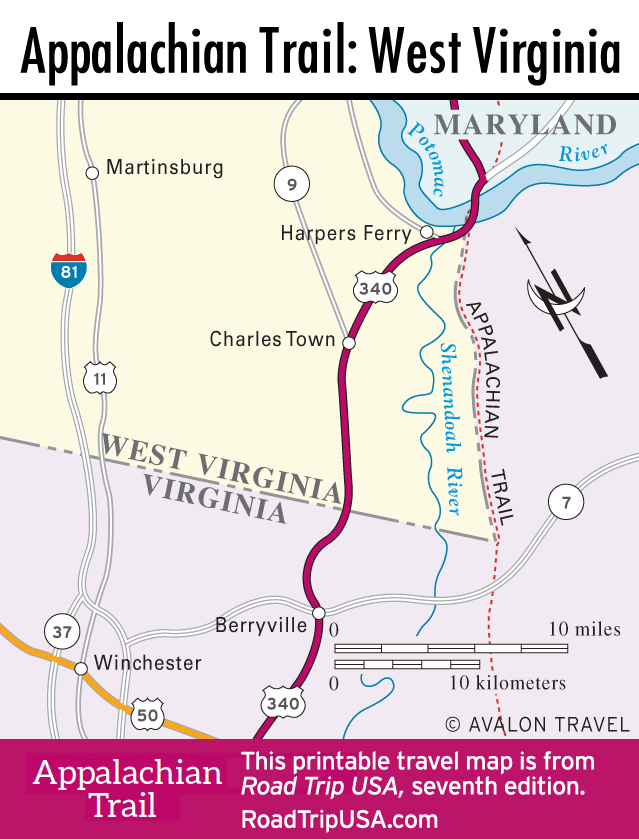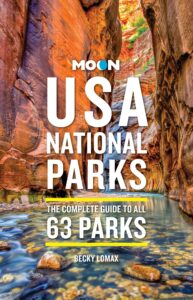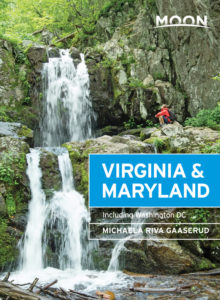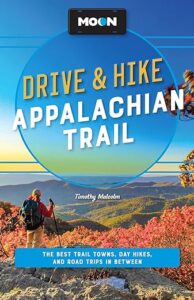West Virginia
Appalachian Trail through West Virginia
In its short run across the eastern tip of West Virginia, US-340 passes through one of the most history-rich small towns in the United States: Harpers Ferry, located at the confluence of the Shenandoah and Potomac Rivers. Lovely mountain scenery surrounds Harpers Ferry, especially during early autumn when the hardwood forests rival Vermont’s for vibrant color.
South of Harpers Ferry, the hikers’ Appalachian Trail runs directly along the Virginia-West Virginia border, east of the Shenandoah River atop the roadless crest of the Blue Ridge Mountains. The best route to follow by car, US-340 swings to the west through the historic mountain resort of Charles Town before entering Virginia.

Harpers Ferry
Climbing the steep slopes of the Blue Ridge Mountains, Harpers Ferry (pop. 281) embodies the industrial and political history of the early United States. Protected since 1963 as a national park, its many well-preserved wood, brick, and stone buildings are palpable reminders of early American enterprise: Besides the country’s first large factory, first canal, and first railroad, scenic Harpers Ferry saw abolitionist John Brown’s 1859 rebellion against slavery, and it was later a strategic site during the Civil War. Harpers Ferry was also home to Storer College, an African American college that operated here from the 1860s until 1955.
Small museums, housed in separate buildings along Shenandoah and High Streets along the riverfront in the “Lower Town,” trace the various strands of the town’s past. From the Shenandoah River, the Appalachian Trail (AT) winds south down what the third president called “one of the most stupendous scenes in Nature,” Jefferson’s Rock. Crossing the Potomac River to the north, the AT climbs up to Maryland Heights for more spectacular vistas.
Especially in summer, the best first stop is the small visitors center (304/535-6029, daily, $10 per person, $20 per vehicle) above the town along US-340. Park here and take one of the frequent free shuttles down to the historic area, as parking elsewhere is limited. Although most of Harpers Ferry is preserved as a historic site, there is considerable pressure to “develop” surrounding lands, so get here while it’s still nice. The eastern portions along the Potomac riverfront have remained in private hands, and here you can indulge your taste for American food, wax museums, and schlocky souvenirs. There’s excellent cycling, a couple of companies offer white-water rafting trips, and for another sort of adventure, you can head down to the cute red clapboard depot and hop aboard one of the Amtrak/MARC trains, which run to Washington DC on a limited schedule. To get the most out of a visit, stay overnight at the lovingly restored, circa-1790s, Federal-style brick-fronted Jackson Rose Bed and Breakfast (1167 W. Washington St., 304/535-1528, $140 and up).
Charles Town
Founded in 1786, the former colonial resort of Charles Town (pop. 6,064) was named in honor of George Washington’s younger brother Charles, who surveyed the site on behalf of Lord Fairfax. Many of the streets are named after other family members, over 75 of whom are buried in the cemetery alongside the Zion Episcopal Church, on Congress Street on the east side of town. Charles Town, which shouldn’t be confused with the West Virginia state capital, Charleston, later played a significant role in John Brown’s failed raid on Harpers Ferry. After Brown was captured, he was tried and convicted of treason in the Jefferson County Courthouse at the corner of George and Washington Streets and hanged a month later. With his last words, Brown noted the inevitable approach of the Civil War, saying he was “quite certain that the crimes of this guilty land will never be purged away but with blood.” A small museum (11am-4pm Tues.-Sat., $4 adult) operates on the first floor of the town library, a block from the old courthouse on Washington and South Samuel Streets.
South of Charles Town, US-340 winds along the western slopes of the Appalachians for a dozen miles before entering Virginia east of Winchester.
















